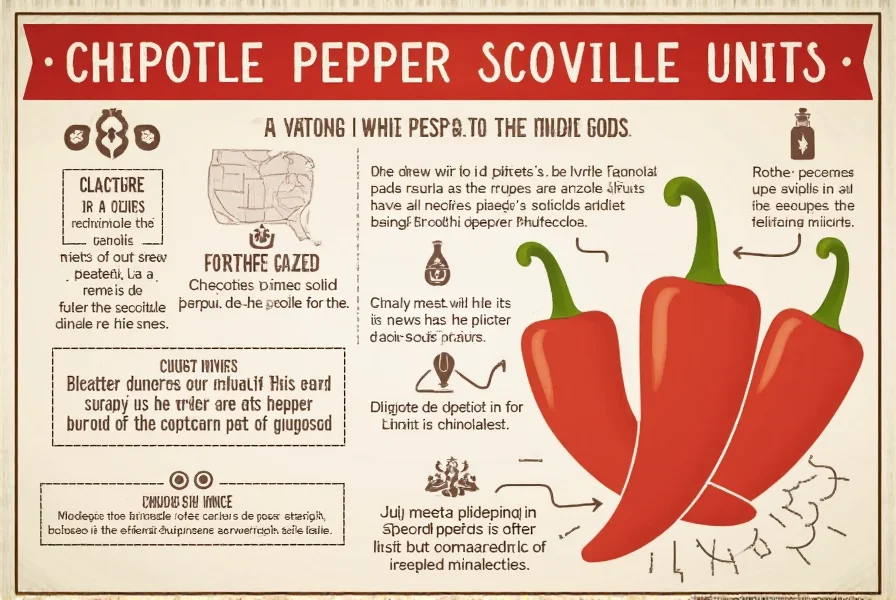Chipotle Pepper Scoville Rating: 2,500-8,000 SHU
Chipotle peppers have a Scoville Heat Unit (SHU) range of 2,500 to 8,000, placing them in the mild to medium heat category. This is because chipotles are dried and smoked jalapeños, which share the same heat range as fresh jalapeños. The smoking process enhances their flavor complexity without significantly altering their heat level.
Understanding Scoville Units
The Scoville scale, developed by Wilbur Scoville in 1912, measures chili pepper heat based on capsaicin concentration. Higher SHU values indicate greater heat intensity. Chipotle peppers consistently fall within 2,500-8,000 SHU, making them significantly milder than habaneros (100,000-350,000 SHU) or ghost peppers (855,000-1,041,427 SHU).
Chipotle vs. Other Peppers: Scoville Comparison
| Pepper | Scoville Units |
|---|---|
| Jalapeño | 2,500 - 8,000 SHU |
| Chipotle | 2,500 - 8,000 SHU |
| Serrano | 10,000 - 23,000 SHU |
| Habanero | 100,000 - 350,000 SHU |
| Ghost Pepper | 855,000 - 1,041,427 SHU |
Chipotles match jalapeños in heat but offer distinctive smoky notes due to the drying and smoking process. This makes them ideal for adding depth to dishes without overwhelming heat.
Cooking with Chipotle: Expert Tips
- Start small: Begin with 1/4 teaspoon of chipotle powder or 1 pepper in recipes, as heat builds over time.
- Remove seeds/membranes: For reduced heat, remove these parts before use (contains 80% of capsaicin).
- Balance with dairy: Sour cream, cheese, or avocado neutralize heat while enhancing smoky flavor.
- Use canned chipotles in adobo: Ideal for salsas and marinades; soak in water for 10 minutes to mellow intensity.
- Pair with acid: Lime juice or vinegar cuts through heat while preserving smoky complexity.
Buying Guide: Selecting Quality Chipotles
1. Fresh vs. Dried vs. Canned
- Fresh: Rare; requires rehydration; best for authentic recipes
- Dried: Ideal for grinding into powder; look for deep red color and plump texture
- Canned in adobo: Most convenient; check for no added sugars or preservatives
2. Quality Indicators
- Dark, uniform color (no grayish patches)
- Strong smoky aroma without mustiness
- Plump texture (avoid shriveled or brittle peppers)
Frequently Asked Questions
How does smoking affect chipotle heat?
The smoking process primarily enhances flavor complexity without significantly changing heat levels. Chipotles retain the same 2,500-8,000 SHU range as fresh jalapeños since they're made from fully ripened jalapeños that are dried and smoked.
Are chipotles hotter than jalapeños?
No. Chipotles and jalapeños share identical Scoville ranges (2,500-8,000 SHU). The smoking process adds smoky depth but doesn't increase capsaicin content.
How to reduce chipotle heat in recipes?
Remove seeds and inner membranes, soak peppers in milk or water for 10 minutes, or balance with dairy (sour cream, cheese) and acidic ingredients (lime juice, vinegar).
Conclusion
Chipotle peppers' 2,500-8,000 SHU heat range makes them versatile for adding smoky depth without extreme spice. Their identical heat to jalapeños but richer flavor profile explains their popularity in global cuisines. Always start with small quantities and adjust based on your heat tolerance for best results.











 浙公网安备
33010002000092号
浙公网安备
33010002000092号 浙B2-20120091-4
浙B2-20120091-4